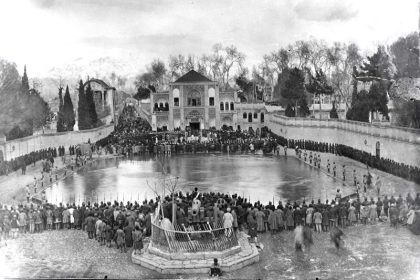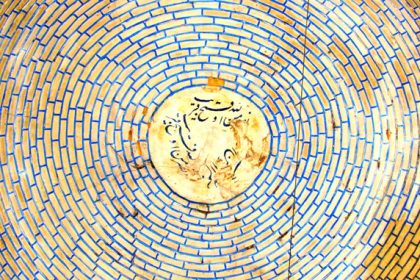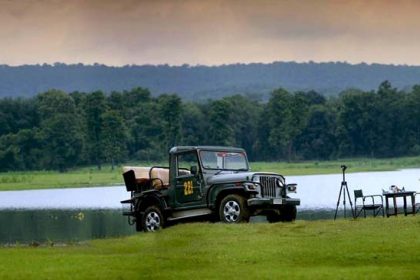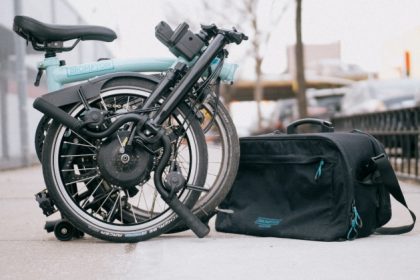This work was submitted by a participant for Hezarvik Safar (Alibaba travel writing contest-1401) and in Alibaba tourism magazine has been published.
“Everyone you meet is fighting on a field you know nothing about! So be kind, always…”
I wanted one of these sentences to be included in the travelogue of Istanbul. A verse that caught my attention on the door of a mansion on the last day of my trip to Dubai, a sentence that was constantly circulating in my mind before the trip, and a quote that Fatima had published along with her picture on Esteghlal Street in Istanbul.

If I were to break down each of these sentences, pages could be written for it.
Learning is not the first step in the flow of life. Life begins and flows with movement. Movement is necessary for learning, and after training, it is movement that gives life to what has been learned and brings it to fruition.
Traveling is a good excuse and destination to get moving. You leave your home and city somewhere, you get hands on all kinds of artefacts that mankind has spent its history building, in order to move and, in my interpretation, to live.
Then you take the battlefield inside you with you, you take it from city to city until you reach Takhim Square and Esteghlal Street!


How well that famous promise is consistent with this place.
For me, as I walk from Bilorjo Street and Siraselweiler Street to Taksim Square, the first thing that catches my attention is the huge building of Aia Triada, a Roman Orthodox church, while a little further on I see the huge building of a newly built mosque. .
Under the spring rain of Istanbul, passing by the alleys with a steep slope, whose stone pavement, stone buildings and their narrowness are very similar to the streets of Eastern European lands, I reach Taksim Square and the beginning of Esteghlal Street.
Regardless of the colorful people passing by and the question in the corner of the mind that what kind of internal war the people of this city could be, the statue in the middle of the square is a monument to the Republic and Mustafa Atatürk, although it is a symbol of the end of the war of independence, but in a land where coups successively, in order to establish democracy, it feels like a fire under the ashes.
I think a lot about this airiness, this uncertainty and this dual sense of being both Eastern and Western in this city.
Istanbul is attractive to me. For me, no matter how many times I have seen a turquoise mosque and a Gothic church, I am still fascinated and fascinated by the window frame that puts the view of the stone mosques with minarets of the city of a thousand mosques on the coast of the Marmara Sea in front of my eyes every morning and evening from the seventh floor of the hotel. A Muslim tourist that Halal tourism makes my trip easier.
Istanbul is also very attractive for western tourists, so that Europeans are the most tourists entering this city. Those who usually seek to explore the history and conditions of the people, but at the same time, in this city, there are more means of entertainment than in other Islamic lands.
Undoubtedly, this airiness and being both eastern and western has historical and cultural roots, in the land that is the crossing of east and west; Not only geographically, but also historically and culturally.
Taksim Square is also the focal point of public transportation in Istanbul. The old red and yellow trams of the city, which are now more touristic, run in Taksim Square and Esteghlal Street. Istanbul Tour double-decker buses depart from here in the morning, and the central metro station is located in this square.
In a big city like Istanbul, commuting by metro is a good experience both in terms of economic efficiency and access to various destinations in the city. In addition, by purchasing a rechargeable Istanbul card, discounts are included for passengers.
From Taksim station, the green line of the metro not only has access to the red, pink, and blue lines, but also a cable train that leads to Kabatash station, providing easy access to the pier for shipping, as well as a tram line that goes to historical areas such as the Sultanahmet district. has done
Regarding the name of Taksim Square, which means division, it is said that in the early Ottoman period, this square was used as a place to collect and send water to the whole city, and hence it was called Taksim, which is called Taksim in Istanbul Turkish.
One of the interesting features of Turkey, especially for someone who is interested in linguistics, is the influence of the country’s politics on language changes.
This word is an example that shows that despite the changes caused by the Arabic script to Latin, as well as the de-Arabization and de-Persianization by Atatürk, familiar words from the Istanbul Turkish language can still be heard, or with a little familiarity with the script of this language, you can read words that are for a They are familiar with the East.
I make a circle around the square and go to the newly built mosque in Taksim square, with its stone facade and numerous domes, its architectural style is similar to the historical mosques of Turkey.
I go up the stairs of the entrance of Esteghlal street to the mosque from the sights of Istanbul. Under the first small dome of the mosque, there is a circular and terrace-like area in which a number of tables and chairs are arranged, and on a column of it is written: “Taksim Kafi”
A narrow corridor with a width of about two meters between a mosque of this grandeur and the narrow and long building in front of it, and it seems that there is a connection between this table and chairs of the mosque’s nave and the cafe that is located opposite and parallel to the mosque.
It seems to me a strange but interesting placement and use. I will not go further. I go back to the food shops of Taksim Square and the steep alleys that I passed by.
It is near the sunset and iftar of Ramadan. For this reason, the confectioners not only put baklavas with different colors and shapes on the counter, but the confectioners are preparing hot desserts in very small spirit trays that are cooking on small stoves behind the glass of the confectionary.
The flame of the Turkish barbecue oven has been lit, and apart from fast food, there are also delicatessens that have foods with a familiar shape and appearance on their counters.
I enter the side streets, whose steep slope arouses a person’s curiosity. A mix of hotels, cafes, McDonald’s, small and large supermarkets and colorful and glazed fruit shops are scattered among new and old residential buildings in the winding cobbled slopes and continuous stairs.
In between, there is a 17th century mosque with a single minaret called Kazanji Ali Agha. In front of the mosque, there is a mihrab-shaped structure with inscriptions carved on the stone, which is a water fountain built in the 18th century.
Such small historical buildings are seen a lot in the heart of the modernized urban fabric in Istanbul. If we consider the use of these inactive water springs to be something similar to our own drinking fountains, next to small and large mosques in the neighborhood of historical churches, we will find the eastern spirit of the city.
The city of frequent brands
I head back to the hotel to explore the surrounding alleys to identify stores that can supply a week’s worth of daily needs.
I pass by a “Shock” supermarket chain and come across a Carrefour minimarket. With a thumb calculation, the price of many goods and foods seems cheaper than in Iran, especially the goods sold under the Carrefour brand have very low prices.
If we want to talk about the brand in Istanbul, one of its battles is to keep up with the world’s brand makers, among its hallmarks is the incredible repetition of established brands across the city, at least on the scale I saw.
If you walk from the beginning to the end of Esteghlal street, you can almost reach a branch of each of the prominent brands present in this city. The main brands are repeated in almost all the main shopping centers of the city.
The length and width of this Asian-European city is so long and wide that probably a high percentage of products in the range of chicken milk to human life with different qualities can be found in this city.
One of Türkiye’s undoubted attractions is the country’s textile industry; A clean and light industry that is active even in the apartment units of four or five-story buildings located in the narrow streets of the city.
An elegant and artistic industry that probably slowly conquered the world market with small steps and became the first industry of this country without pollution and noise.
Dream islands
In a metropolis spread between the Black Sea and the Sea of Marmara, a sea cruise can be the most exciting travel experience.
From Kabatash pier, by paying about 25 lira through Istanbul card, you can get on a ship with a capacity of about 100 people, which after stopping at Qazikoy station, goes to the four princess islands and after an hour and 45 minutes, passengers get off at the fourth island. .
The green recreational islands of Istanbul are located in the Sea of Marmara and beautiful private villas are built there, which are said to be mostly owned by Christians and Jews of Istanbul.
The fuel needed in these dream islands is obtained from clean energies; Electric cars are used when necessary, but cycling and walking are the predominant culture and tourist activity in these islands.
The fourth island, which is open to the public, is called Buyukada, although the tiles on the old building of its station say ‘Buyuk Ata’. This is another characteristic linguistic change.
Upon entering the island, travelers are welcomed by the voice of the ice cream sellers in Farsi and with a Turkish accent. Ice cream scoops are skilfully assembled in the form of dolls and snowmen, the canopies of cafes and restaurants serving travelers on the terrace of the buildings are lined up and open.
Store facades are wooden. A small clock is placed in the middle of the small square of the island. Small and large goods of beach shops are arranged under the umbrellas and up to the middle of the narrow alleys of the island. Hand-woven knits and hand-embroidered stitches are eye-catching.
The coexistence of humans and cats is more visible in Istanbul than anywhere else. The people’s lips are smiling and the gentle afternoon sun completes the gentle feeling of happiness and joy of being on the island.
Undoubtedly, Buick Ata is worth at least one night’s stay, but even a few hours of patrolling in it creates such a pleasant mood that you can pass it with hope; He remembered the color of the sun and whispered in her ear: “I’ll be back, for sure!”
But the island brings its warmth with us on the way back to Istanbul. The solitude of a spring evening, in the sunshine, sitting on the narrow deck at the side of the ship and feeding the seagulls with Sara’s little hands!
There are only a handful of these beautiful days in a person’s life. From these days in which you live a real dream, in which you can lay down the burden of the battlefield that you have been carrying for a long time; because you have seen the beauty of life once again with your eyes and touched it on your skin; From the clarity of the water and the sunshine on your face, it is as if you have been freed from the vegetable life and found a new life!
The city of a thousand mosques
In these often rainy days in Istanbul, which are both the end of May 1401 and the month of Ramadan 1443, I wake up in the morning to watch the view of the beach from the window of the suite on the seventh floor of the City Center Hotel, to the view of Galata Tower, Hagia Sophia Mosque and Sultan Ahmed Mosque on the blue background of the sea. I will watch Marmara.
Most days the weather is humid and rainy. As night falls, the rain stops and the “Ramadan Mubarak” strings of the historic mosques, which are stretched between their huge minarets, light up.
Locals say that from Taksim Square and from Esteghlal Street, it is 2 kilometers on foot to Galata Tower and 4 kilometers to Sultan Ahmed District, but the rail route from Taksim Square is the cable metro to Kabatash and then the tram to Sultan Ahmed District. goes
When the tram moves through the narrow streets and historical fabric of Istanbul, full of shops, the European atmosphere of the city is seen again.
It is noon on Friday and visiting the Sultan Ahmed Mosque is only allowed for those who pray. The Blue Mosque and 6 minarets of Istanbul, this unique feature was created as a result of a typo.
It is said that Sultan Ahmed wanted a gold minaret for this mosque, while the similarity of the words “Altin” meaning gold and “Alti” meaning six, misled the architect.
In any case, Sultan Ahmed Mosque has an exemplary grandeur. Although today we are the only ones to enter the courtyard of the mosque and we were lucky enough to pray the afternoon and evening prayers under the blue sky of the mosque, but the courtyard of the mosque is also very beautiful and clean. A single purple tree with pink blossoms stands out in the courtyard of the mosque, and the gardens are decorated with rows of colorful tulips.
We leave the mosque through the door that leads to the Hagia Sophia. The large and beautiful area is located between the Sultan Ahmed Mosque and the Hagia Sophia Mosque, which is an attractive tourist area with wooden benches, flower gardens, palm trees and side buildings.
Hagia Sophia is about 500 meters away from Sultan Ahmed Mosque, but its atmosphere is different from that. Upon entering, the old building is visible. At the entrance of the courtyard, there is a sign that reminds of the obligation to observe hijab in this place, and small scarves are provided to non-hijab women.
I saw this hijab on the condition of prayer and mosque a few days ago in the prayer hall of one of the shopping centers. Women who were not veiled, when they came to the prayer room, they wore a scarf and a long skirt and stood for prayer.
Hagia Sophia, which is originally a Byzantine church built in the 6th century AD, was converted into a mosque after the conquest of Istanbul by Sultan Muhammad Fatih in the Ottoman era and has been active as a museum for the last 90 years, but since Ramadan this year After 88 years, congregational prayers will be held there again.
Combining the symbols of mosque and church and Islam and Christianity has made Hagia Sophia a spectacular place. From the icons of angels around the dome to the calligraphy of the verse “Allah is the light of the heavens and the earth” in the center of the dome’s arch, from the Christian confessional chambers to the Islamic pulpit and altar.
Hagia Sophia has beautiful lighting with large and numerous chandeliers hanging down from its high domes, and its characteristic that distinguishes it in the pictures is the panel of the names of Allah, Muhammad (PBUH), Ali (PBUH), Hassan (PBUH), Hussein. (pbuh), Abu Bakr, Umar and Uthman are on its walls. That is why this building is a living museum that reveals the history of this land.
The city that is the crossing of East and West, as much as it has the coexistence of religions and even religious sects, it has also been a place of conflict and power display for the claimants of Islam and Christianity throughout history, as far as the construction of numerous mosques in Istanbul and its fame to The city of a thousand mosques is considered to be the reason for the spread of Islam against Roman Christianity in this city.
However, it seems that Istanbul today has accepted all the conflicting aspects of its history and culture, and while it has not completely distanced itself from its eastern spirit, it has a view of the West and a desire to become Westernized. This is a difficult and complicated balance that sometimes forces the leaders of this country to behave in opposite ways.
This process is still going on in the present era and this process is one of the developments that should be rejected in today’s world, and it sought to find an answer to the question of what will happen to the fate of Turkey in the see-saw between the East and the West. .
RCO NEWS

















